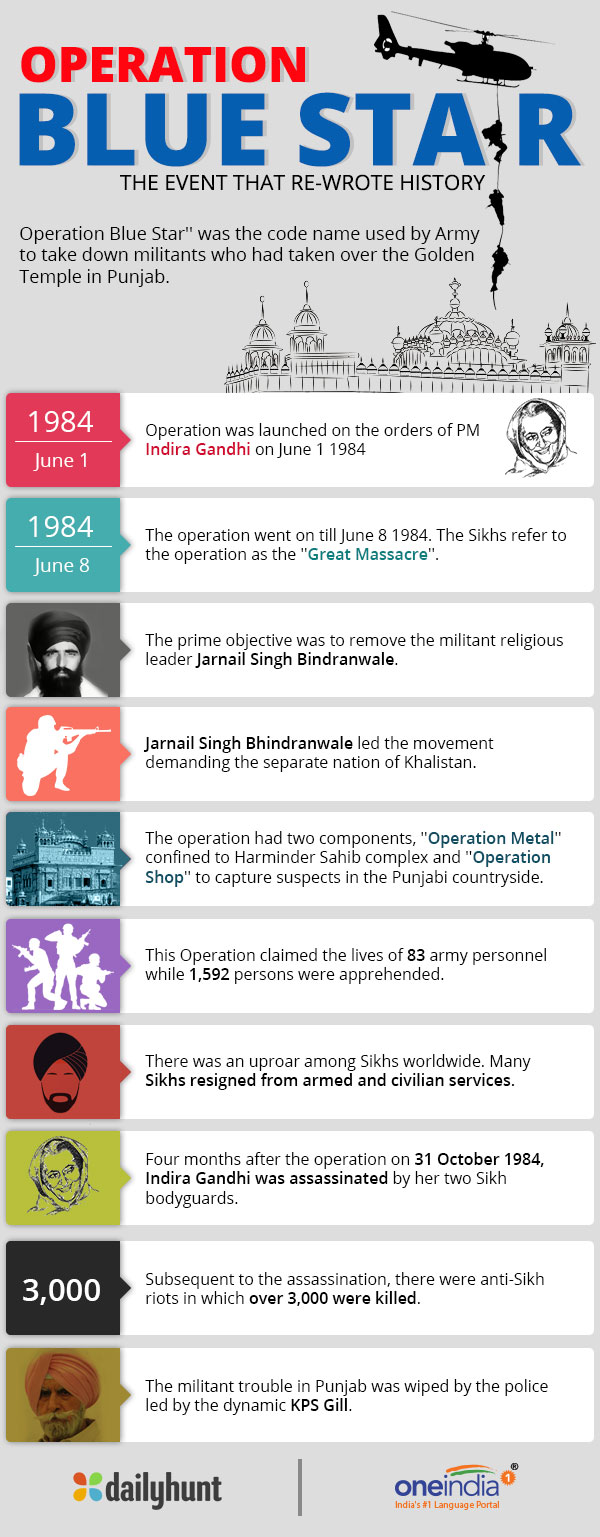
34 years since Operation Blue Star: What led to the birth of the Khalistan Movement
Over three decades back, India witnessed one of the biggest operations carried out against militants born on its own soil. June 1 1984, the Armed Forces launched probably one of the biggest operations in Punjab, which went on to be called as 'Operation Blue Star."

The militants holed up in the Golden Temple were ordered to be killed or captured by the then Prime Minister, Indira Gandhi. The fight was for a separate nation which they wanted to call Khalistan. There were several outfits that were fighting for this cause- The Babbar Khalsa International, Khalistan Zindabad Force, Khalistan Liberation Force, just to name a few.
What is the Khalistan Movement:
The Khalistan movement is a Sikh separatist movement, which sought to create a separate country called Khalistan or the land of the pure. Such a state existed in Punjab between 1709 and 1849 and the Sikh empire back then had its capital in Lahore, Pakistan. Lahore, Pakistan occupied Kashmir, Multan, Pakistani Punjab, FATA and Khyber Pakhtunkhwa formed part of this empire.

The
new
state
created
would
be
called
Khalistan
in
the
modern
territories
of
Eastern
Pakistan
and
Western
India.
Its
stated
capital
would
be
Lahore,
a
city
where
Sikh
empire
was
commenced
by
Maharaja
Ranjit
Singh
and
ruled
for
centuries
by
his
descendants.
During
partition
the
demand
for
Khalistan
began
where
there
for
calls
for
an
independent
state.
The
idea
was
however
not
feasible
owing
to
the
lack
of
Sikh
population
as
compared
to
the
other
religions
in
Punjab.
The demand however died down over the years, but flourished in the 1970s. While the Akali leaders pursued the idea of a more empowered Sikh majority state within India, others such as Jagjit Singh Chauhan, the founder of the Khalistan movement sought for a state independent from India. Two years after losing the 1969 Punjab elections, Singh moved to the United Kingdom and also went to the Nankana Sahib in Pakistan in an attempt to set up a Sikh government.
On 13 October 1971, he placed an advertisement in the New York Times proclaiming an independent state. He returned to India in 1977, following which he went to the United Kingdom where he established the Khalistan National Council. Operating from a building called as the Khalistan House, he stayed in touch with Jarnail Singh, who was a Sikh religious leader.
The early 1980s saw the rise of Bindranwale. Indira Gandhi's Congress party supported Bhindranwale in a bid to split the Sikh votes and weaken the Akali Dal, its main rival in Punjab. Congress supported the candidates backed by Bhindranwale in the 1978 SGPC elections. In the 1980 election, Bhindranwale supported Congress candidates Gurdial Singh Dhillon and Raghunandan Lal Bhatia. Bhindranwale was originally not very influential, but the activities of Congress elevated him to the status of a major leader by the early 1980s.
A violent turn:
The movement however took a violent turn following the assassination of Lala Jagat Narain, the owner of the Hind Samachar Group of newspapers. He was allegedly assassinated by Sikh militants on September 9 1980. He was a critic of Bindranwale and had been advocating Hindi instead of Punjabi as the mother tongue for Hindus living in Punjab.

There were widespread murders in Punjab by followers of Bhindrawale. One such murder was that of DIG Avtar Singh Atwal, who was killed in April 1983 at the gate of the Darbar Sahib. His corpse remained there for 2 hours as even police officers were afraid to touch the body without permission from Bhindranwale.

It was common knowledge that the militants responsible for bombings and murders were taking shelter in some gurdwaras. However, the Congress-led government declared that it could not enter the gurdwaras for the fear of hurting Sikh sentiments. Detailed reports on the open shipping of arms-laden trucks were sent to the Prime Minister Indira Gandhi; however, the Government did not take any action to stop these. Finally, after the murder of six Hindu bus passengers in October 1983, emergency rule was imposed in Punjab, which continued for more than a decade.
The oppression was responded to with violence and the Indian Army reciprocated. In one such incident, the Indian Army forced their way into the Harmandir Sahib, also known as the Golden Temple. Bindranwale had moved into the Golden Temple with some of his followers and began to fortify the temple with heavy machine guns and self loading rifles.
This led to the ordering of Operation Blue Star which began on June 1 1984 to flush out Bindranwale and his followers. The operation led to the killing of Bindranwale, but there was significant military and civilian casualty, alongside damage to the holiest shrine for the Sikhs.


 Click it and Unblock the Notifications
Click it and Unblock the Notifications


































